Organisational Behaviour Report: Tesco Culture and Leadership
VerifiedAdded on 2020/01/28
|21
|6424
|228
Report
AI Summary
This report provides an in-depth analysis of organisational behaviour within Tesco, examining various aspects of leadership, management, and employee motivation. It begins with an evaluation of leadership theories, including trait and behavioural theories, and assesses the impact of different managerial styles, such as authoritarian, democratic, and permissive approaches, on organisational effectiveness. The report further explores motivational theories like Maslow's hierarchy of needs and Herzberg's hygiene theory, illustrating how Tesco applies these concepts to enhance employee engagement and job satisfaction. Additionally, the report delves into the importance of organisational culture and structure, specifically focusing on Tesco, and its impact on overall effectiveness. It also covers innovation, creativity, and the effectiveness of teamwork and change management within the organisation. Finally, the report analyses different approaches to organisational decision-making, including risk and uncertainty management, and evaluates the effectiveness of decisions made by Tesco. This comprehensive analysis aims to provide a clear understanding of how organisational behaviour principles are applied in a real-world business context.
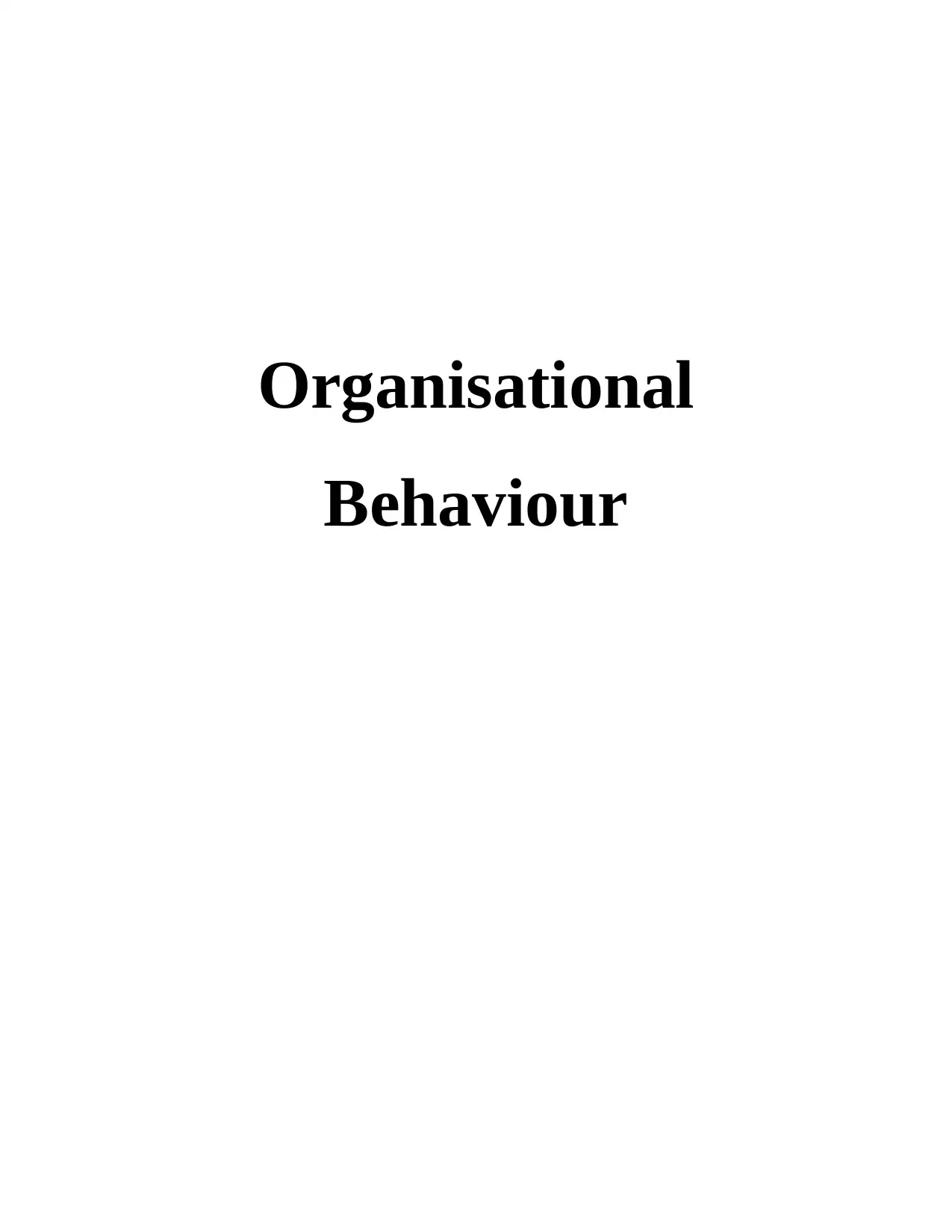
Organisational
Behaviour
Behaviour
Paraphrase This Document
Need a fresh take? Get an instant paraphrase of this document with our AI Paraphraser
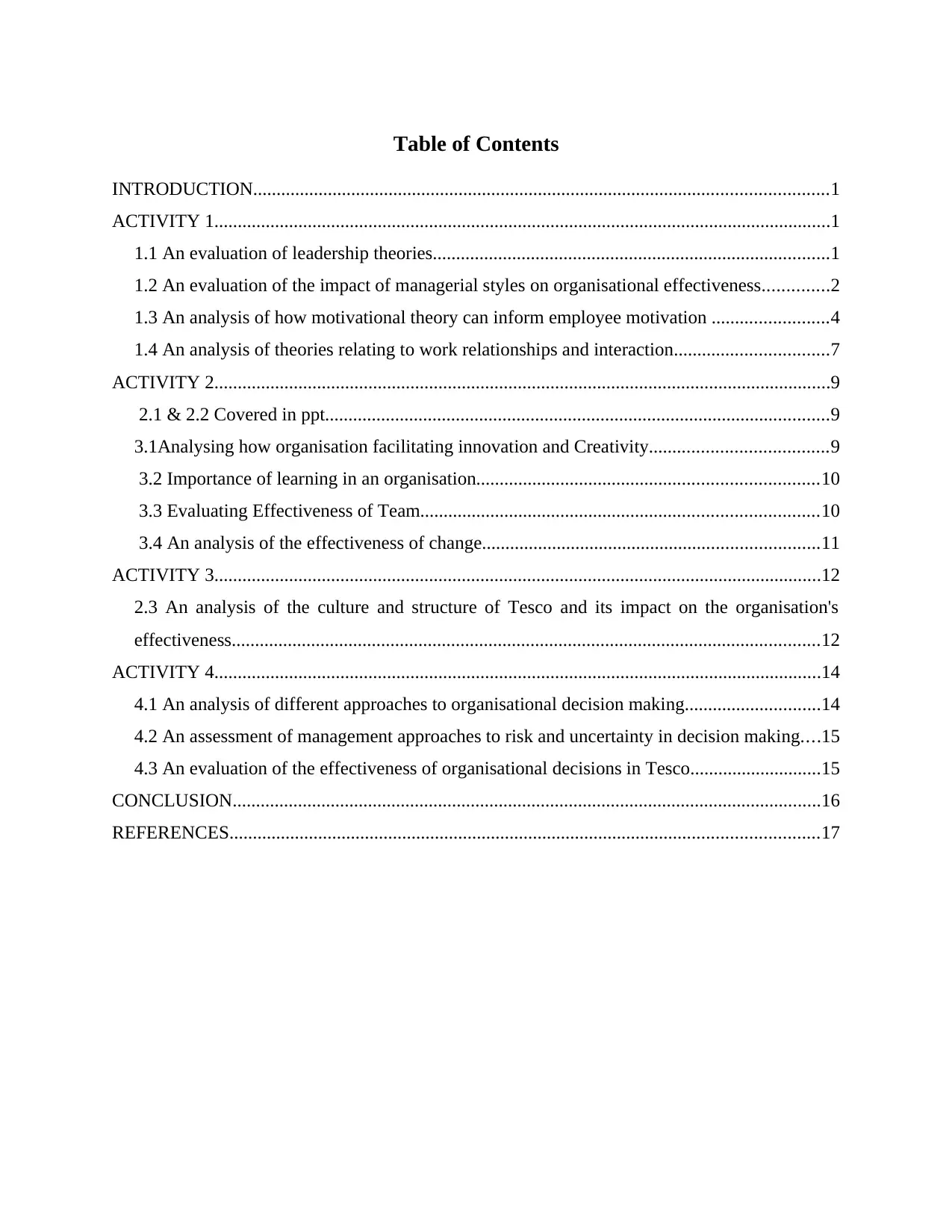
Table of Contents
INTRODUCTION...........................................................................................................................1
ACTIVITY 1....................................................................................................................................1
1.1 An evaluation of leadership theories.....................................................................................1
1.2 An evaluation of the impact of managerial styles on organisational effectiveness..............2
1.3 An analysis of how motivational theory can inform employee motivation .........................4
1.4 An analysis of theories relating to work relationships and interaction.................................7
ACTIVITY 2....................................................................................................................................9
2.1 & 2.2 Covered in ppt............................................................................................................9
3.1Analysing how organisation facilitating innovation and Creativity......................................9
3.2 Importance of learning in an organisation.........................................................................10
3.3 Evaluating Effectiveness of Team.....................................................................................10
3.4 An analysis of the effectiveness of change........................................................................11
ACTIVITY 3..................................................................................................................................12
2.3 An analysis of the culture and structure of Tesco and its impact on the organisation's
effectiveness..............................................................................................................................12
ACTIVITY 4..................................................................................................................................14
4.1 An analysis of different approaches to organisational decision making.............................14
4.2 An assessment of management approaches to risk and uncertainty in decision making....15
4.3 An evaluation of the effectiveness of organisational decisions in Tesco............................15
CONCLUSION..............................................................................................................................16
REFERENCES..............................................................................................................................17
INTRODUCTION...........................................................................................................................1
ACTIVITY 1....................................................................................................................................1
1.1 An evaluation of leadership theories.....................................................................................1
1.2 An evaluation of the impact of managerial styles on organisational effectiveness..............2
1.3 An analysis of how motivational theory can inform employee motivation .........................4
1.4 An analysis of theories relating to work relationships and interaction.................................7
ACTIVITY 2....................................................................................................................................9
2.1 & 2.2 Covered in ppt............................................................................................................9
3.1Analysing how organisation facilitating innovation and Creativity......................................9
3.2 Importance of learning in an organisation.........................................................................10
3.3 Evaluating Effectiveness of Team.....................................................................................10
3.4 An analysis of the effectiveness of change........................................................................11
ACTIVITY 3..................................................................................................................................12
2.3 An analysis of the culture and structure of Tesco and its impact on the organisation's
effectiveness..............................................................................................................................12
ACTIVITY 4..................................................................................................................................14
4.1 An analysis of different approaches to organisational decision making.............................14
4.2 An assessment of management approaches to risk and uncertainty in decision making....15
4.3 An evaluation of the effectiveness of organisational decisions in Tesco............................15
CONCLUSION..............................................................................................................................16
REFERENCES..............................................................................................................................17
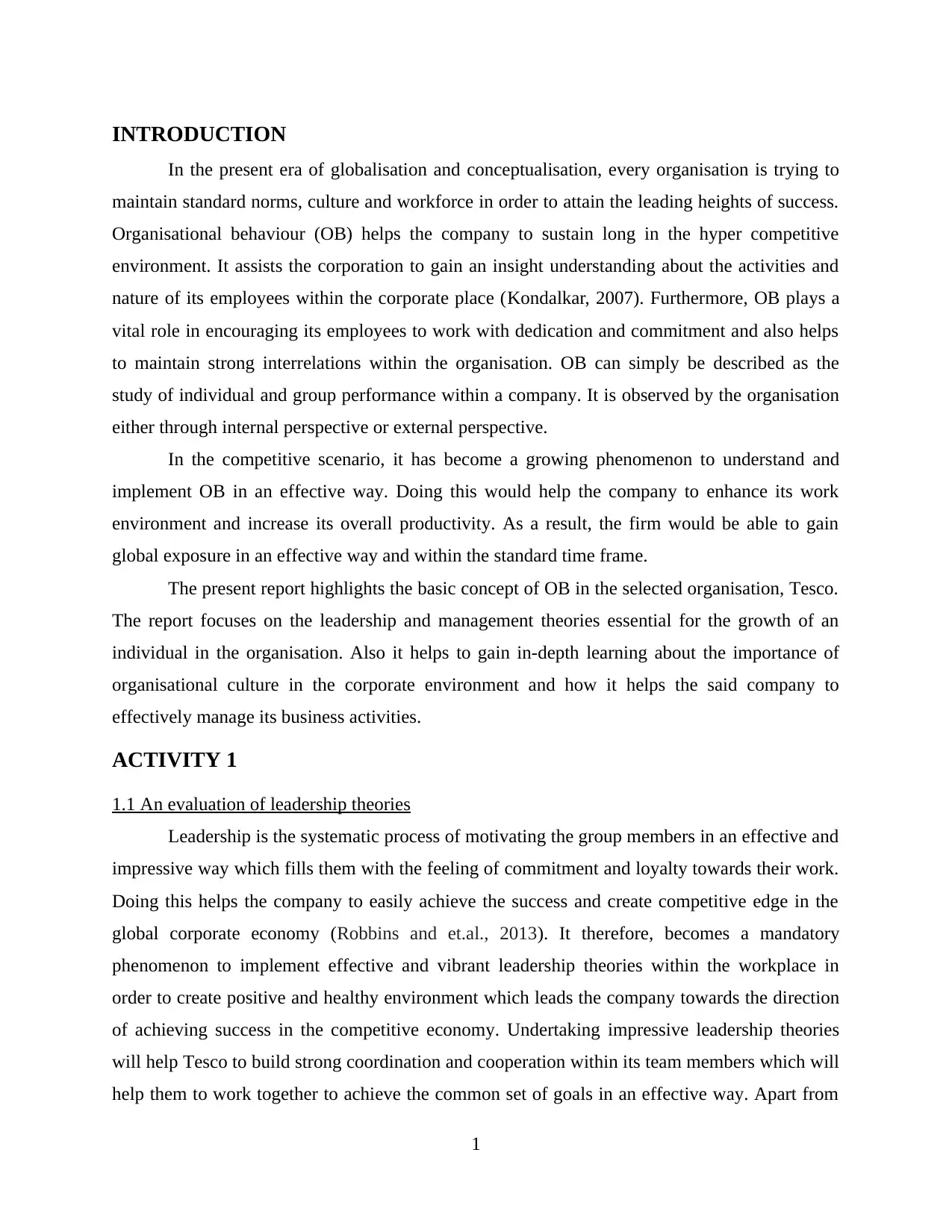
INTRODUCTION
In the present era of globalisation and conceptualisation, every organisation is trying to
maintain standard norms, culture and workforce in order to attain the leading heights of success.
Organisational behaviour (OB) helps the company to sustain long in the hyper competitive
environment. It assists the corporation to gain an insight understanding about the activities and
nature of its employees within the corporate place (Kondalkar, 2007). Furthermore, OB plays a
vital role in encouraging its employees to work with dedication and commitment and also helps
to maintain strong interrelations within the organisation. OB can simply be described as the
study of individual and group performance within a company. It is observed by the organisation
either through internal perspective or external perspective.
In the competitive scenario, it has become a growing phenomenon to understand and
implement OB in an effective way. Doing this would help the company to enhance its work
environment and increase its overall productivity. As a result, the firm would be able to gain
global exposure in an effective way and within the standard time frame.
The present report highlights the basic concept of OB in the selected organisation, Tesco.
The report focuses on the leadership and management theories essential for the growth of an
individual in the organisation. Also it helps to gain in-depth learning about the importance of
organisational culture in the corporate environment and how it helps the said company to
effectively manage its business activities.
ACTIVITY 1
1.1 An evaluation of leadership theories
Leadership is the systematic process of motivating the group members in an effective and
impressive way which fills them with the feeling of commitment and loyalty towards their work.
Doing this helps the company to easily achieve the success and create competitive edge in the
global corporate economy (Robbins and et.al., 2013). It therefore, becomes a mandatory
phenomenon to implement effective and vibrant leadership theories within the workplace in
order to create positive and healthy environment which leads the company towards the direction
of achieving success in the competitive economy. Undertaking impressive leadership theories
will help Tesco to build strong coordination and cooperation within its team members which will
help them to work together to achieve the common set of goals in an effective way. Apart from
1
In the present era of globalisation and conceptualisation, every organisation is trying to
maintain standard norms, culture and workforce in order to attain the leading heights of success.
Organisational behaviour (OB) helps the company to sustain long in the hyper competitive
environment. It assists the corporation to gain an insight understanding about the activities and
nature of its employees within the corporate place (Kondalkar, 2007). Furthermore, OB plays a
vital role in encouraging its employees to work with dedication and commitment and also helps
to maintain strong interrelations within the organisation. OB can simply be described as the
study of individual and group performance within a company. It is observed by the organisation
either through internal perspective or external perspective.
In the competitive scenario, it has become a growing phenomenon to understand and
implement OB in an effective way. Doing this would help the company to enhance its work
environment and increase its overall productivity. As a result, the firm would be able to gain
global exposure in an effective way and within the standard time frame.
The present report highlights the basic concept of OB in the selected organisation, Tesco.
The report focuses on the leadership and management theories essential for the growth of an
individual in the organisation. Also it helps to gain in-depth learning about the importance of
organisational culture in the corporate environment and how it helps the said company to
effectively manage its business activities.
ACTIVITY 1
1.1 An evaluation of leadership theories
Leadership is the systematic process of motivating the group members in an effective and
impressive way which fills them with the feeling of commitment and loyalty towards their work.
Doing this helps the company to easily achieve the success and create competitive edge in the
global corporate economy (Robbins and et.al., 2013). It therefore, becomes a mandatory
phenomenon to implement effective and vibrant leadership theories within the workplace in
order to create positive and healthy environment which leads the company towards the direction
of achieving success in the competitive economy. Undertaking impressive leadership theories
will help Tesco to build strong coordination and cooperation within its team members which will
help them to work together to achieve the common set of goals in an effective way. Apart from
1
⊘ This is a preview!⊘
Do you want full access?
Subscribe today to unlock all pages.

Trusted by 1+ million students worldwide
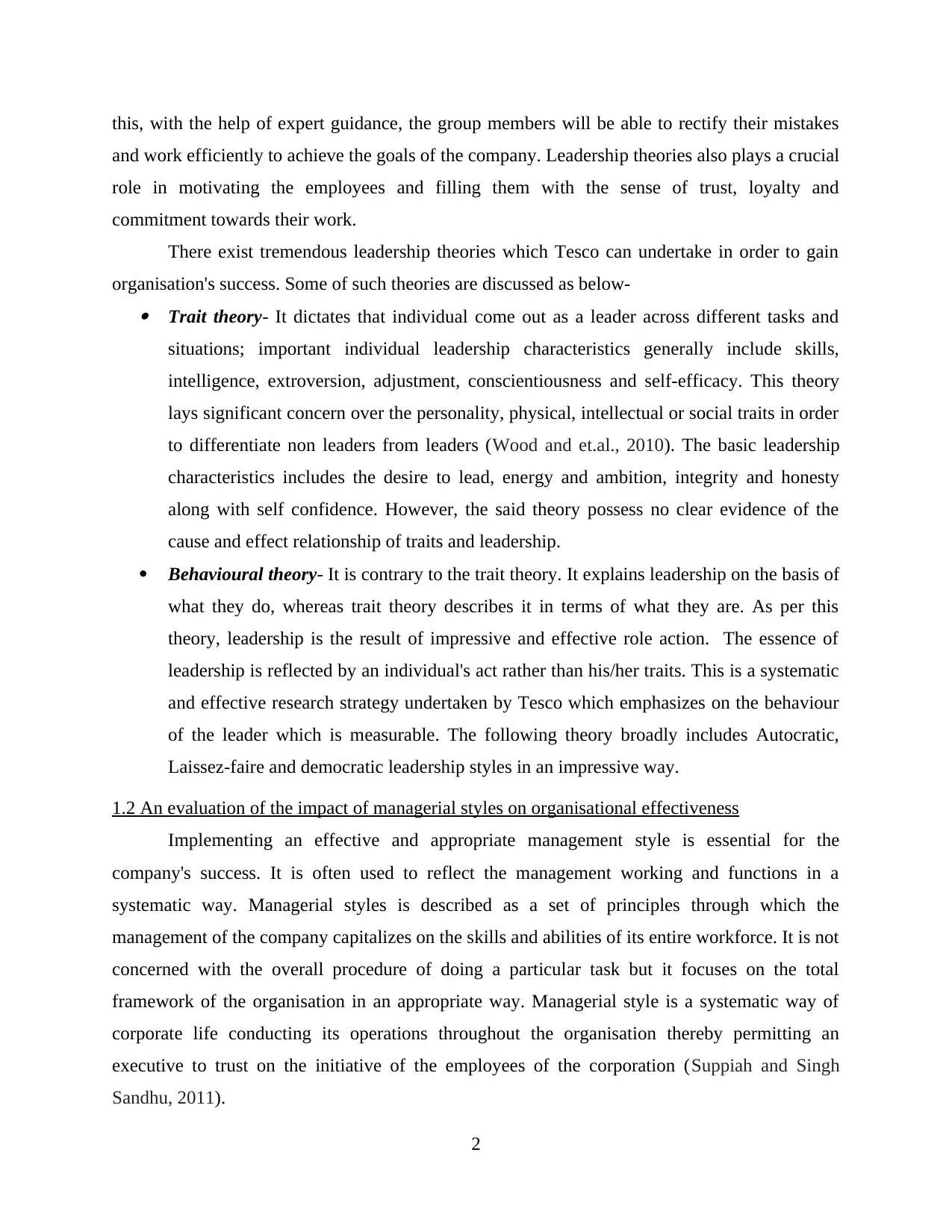
this, with the help of expert guidance, the group members will be able to rectify their mistakes
and work efficiently to achieve the goals of the company. Leadership theories also plays a crucial
role in motivating the employees and filling them with the sense of trust, loyalty and
commitment towards their work.
There exist tremendous leadership theories which Tesco can undertake in order to gain
organisation's success. Some of such theories are discussed as below- Trait theory- It dictates that individual come out as a leader across different tasks and
situations; important individual leadership characteristics generally include skills,
intelligence, extroversion, adjustment, conscientiousness and self-efficacy. This theory
lays significant concern over the personality, physical, intellectual or social traits in order
to differentiate non leaders from leaders (Wood and et.al., 2010). The basic leadership
characteristics includes the desire to lead, energy and ambition, integrity and honesty
along with self confidence. However, the said theory possess no clear evidence of the
cause and effect relationship of traits and leadership.
Behavioural theory- It is contrary to the trait theory. It explains leadership on the basis of
what they do, whereas trait theory describes it in terms of what they are. As per this
theory, leadership is the result of impressive and effective role action. The essence of
leadership is reflected by an individual's act rather than his/her traits. This is a systematic
and effective research strategy undertaken by Tesco which emphasizes on the behaviour
of the leader which is measurable. The following theory broadly includes Autocratic,
Laissez-faire and democratic leadership styles in an impressive way.
1.2 An evaluation of the impact of managerial styles on organisational effectiveness
Implementing an effective and appropriate management style is essential for the
company's success. It is often used to reflect the management working and functions in a
systematic way. Managerial styles is described as a set of principles through which the
management of the company capitalizes on the skills and abilities of its entire workforce. It is not
concerned with the overall procedure of doing a particular task but it focuses on the total
framework of the organisation in an appropriate way. Managerial style is a systematic way of
corporate life conducting its operations throughout the organisation thereby permitting an
executive to trust on the initiative of the employees of the corporation (Suppiah and Singh
Sandhu, 2011).
2
and work efficiently to achieve the goals of the company. Leadership theories also plays a crucial
role in motivating the employees and filling them with the sense of trust, loyalty and
commitment towards their work.
There exist tremendous leadership theories which Tesco can undertake in order to gain
organisation's success. Some of such theories are discussed as below- Trait theory- It dictates that individual come out as a leader across different tasks and
situations; important individual leadership characteristics generally include skills,
intelligence, extroversion, adjustment, conscientiousness and self-efficacy. This theory
lays significant concern over the personality, physical, intellectual or social traits in order
to differentiate non leaders from leaders (Wood and et.al., 2010). The basic leadership
characteristics includes the desire to lead, energy and ambition, integrity and honesty
along with self confidence. However, the said theory possess no clear evidence of the
cause and effect relationship of traits and leadership.
Behavioural theory- It is contrary to the trait theory. It explains leadership on the basis of
what they do, whereas trait theory describes it in terms of what they are. As per this
theory, leadership is the result of impressive and effective role action. The essence of
leadership is reflected by an individual's act rather than his/her traits. This is a systematic
and effective research strategy undertaken by Tesco which emphasizes on the behaviour
of the leader which is measurable. The following theory broadly includes Autocratic,
Laissez-faire and democratic leadership styles in an impressive way.
1.2 An evaluation of the impact of managerial styles on organisational effectiveness
Implementing an effective and appropriate management style is essential for the
company's success. It is often used to reflect the management working and functions in a
systematic way. Managerial styles is described as a set of principles through which the
management of the company capitalizes on the skills and abilities of its entire workforce. It is not
concerned with the overall procedure of doing a particular task but it focuses on the total
framework of the organisation in an appropriate way. Managerial style is a systematic way of
corporate life conducting its operations throughout the organisation thereby permitting an
executive to trust on the initiative of the employees of the corporation (Suppiah and Singh
Sandhu, 2011).
2
Paraphrase This Document
Need a fresh take? Get an instant paraphrase of this document with our AI Paraphraser
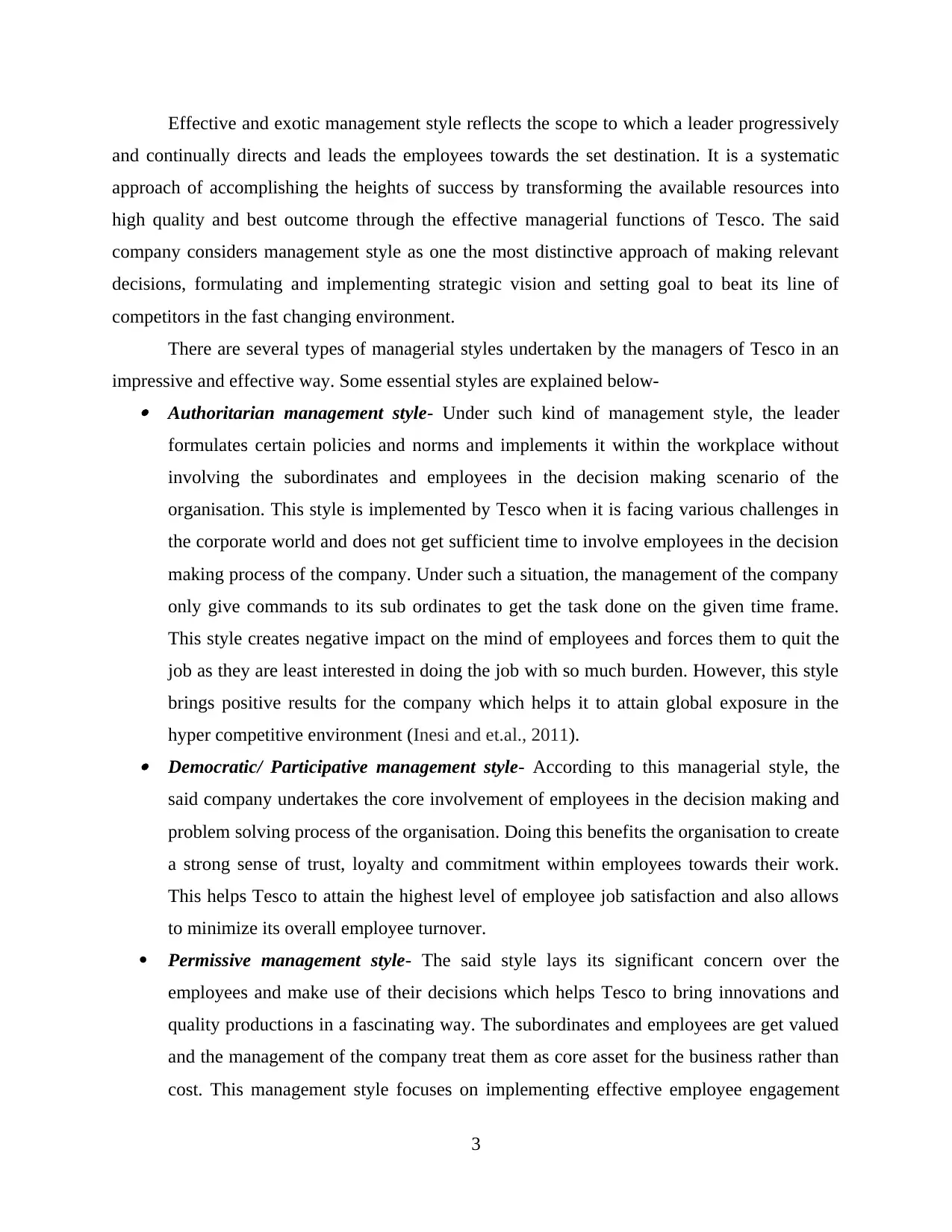
Effective and exotic management style reflects the scope to which a leader progressively
and continually directs and leads the employees towards the set destination. It is a systematic
approach of accomplishing the heights of success by transforming the available resources into
high quality and best outcome through the effective managerial functions of Tesco. The said
company considers management style as one the most distinctive approach of making relevant
decisions, formulating and implementing strategic vision and setting goal to beat its line of
competitors in the fast changing environment.
There are several types of managerial styles undertaken by the managers of Tesco in an
impressive and effective way. Some essential styles are explained below- Authoritarian management style- Under such kind of management style, the leader
formulates certain policies and norms and implements it within the workplace without
involving the subordinates and employees in the decision making scenario of the
organisation. This style is implemented by Tesco when it is facing various challenges in
the corporate world and does not get sufficient time to involve employees in the decision
making process of the company. Under such a situation, the management of the company
only give commands to its sub ordinates to get the task done on the given time frame.
This style creates negative impact on the mind of employees and forces them to quit the
job as they are least interested in doing the job with so much burden. However, this style
brings positive results for the company which helps it to attain global exposure in the
hyper competitive environment (Inesi and et.al., 2011). Democratic/ Participative management style- According to this managerial style, the
said company undertakes the core involvement of employees in the decision making and
problem solving process of the organisation. Doing this benefits the organisation to create
a strong sense of trust, loyalty and commitment within employees towards their work.
This helps Tesco to attain the highest level of employee job satisfaction and also allows
to minimize its overall employee turnover.
Permissive management style- The said style lays its significant concern over the
employees and make use of their decisions which helps Tesco to bring innovations and
quality productions in a fascinating way. The subordinates and employees are get valued
and the management of the company treat them as core asset for the business rather than
cost. This management style focuses on implementing effective employee engagement
3
and continually directs and leads the employees towards the set destination. It is a systematic
approach of accomplishing the heights of success by transforming the available resources into
high quality and best outcome through the effective managerial functions of Tesco. The said
company considers management style as one the most distinctive approach of making relevant
decisions, formulating and implementing strategic vision and setting goal to beat its line of
competitors in the fast changing environment.
There are several types of managerial styles undertaken by the managers of Tesco in an
impressive and effective way. Some essential styles are explained below- Authoritarian management style- Under such kind of management style, the leader
formulates certain policies and norms and implements it within the workplace without
involving the subordinates and employees in the decision making scenario of the
organisation. This style is implemented by Tesco when it is facing various challenges in
the corporate world and does not get sufficient time to involve employees in the decision
making process of the company. Under such a situation, the management of the company
only give commands to its sub ordinates to get the task done on the given time frame.
This style creates negative impact on the mind of employees and forces them to quit the
job as they are least interested in doing the job with so much burden. However, this style
brings positive results for the company which helps it to attain global exposure in the
hyper competitive environment (Inesi and et.al., 2011). Democratic/ Participative management style- According to this managerial style, the
said company undertakes the core involvement of employees in the decision making and
problem solving process of the organisation. Doing this benefits the organisation to create
a strong sense of trust, loyalty and commitment within employees towards their work.
This helps Tesco to attain the highest level of employee job satisfaction and also allows
to minimize its overall employee turnover.
Permissive management style- The said style lays its significant concern over the
employees and make use of their decisions which helps Tesco to bring innovations and
quality productions in a fascinating way. The subordinates and employees are get valued
and the management of the company treat them as core asset for the business rather than
cost. This management style focuses on implementing effective employee engagement
3
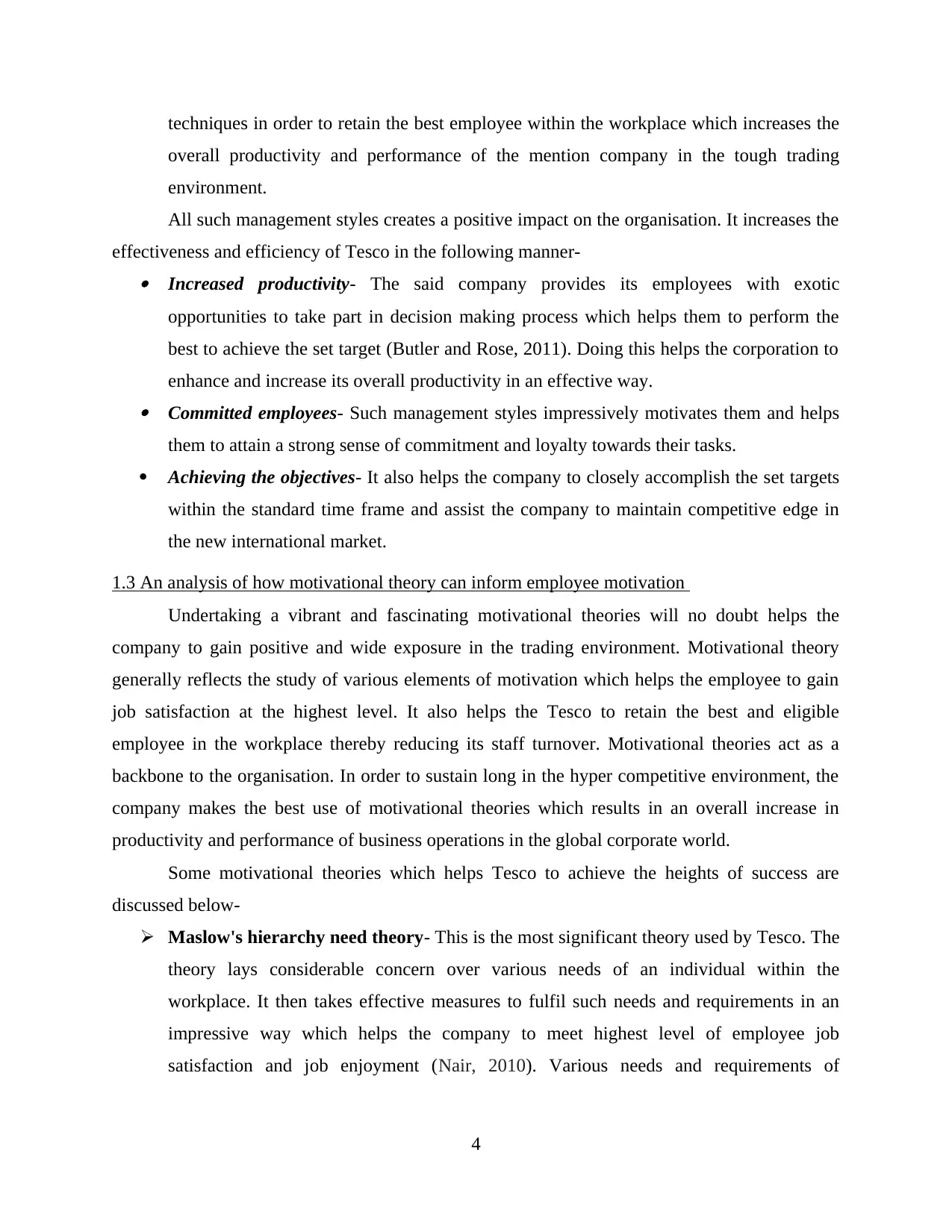
techniques in order to retain the best employee within the workplace which increases the
overall productivity and performance of the mention company in the tough trading
environment.
All such management styles creates a positive impact on the organisation. It increases the
effectiveness and efficiency of Tesco in the following manner- Increased productivity- The said company provides its employees with exotic
opportunities to take part in decision making process which helps them to perform the
best to achieve the set target (Butler and Rose, 2011). Doing this helps the corporation to
enhance and increase its overall productivity in an effective way. Committed employees- Such management styles impressively motivates them and helps
them to attain a strong sense of commitment and loyalty towards their tasks.
Achieving the objectives- It also helps the company to closely accomplish the set targets
within the standard time frame and assist the company to maintain competitive edge in
the new international market.
1.3 An analysis of how motivational theory can inform employee motivation
Undertaking a vibrant and fascinating motivational theories will no doubt helps the
company to gain positive and wide exposure in the trading environment. Motivational theory
generally reflects the study of various elements of motivation which helps the employee to gain
job satisfaction at the highest level. It also helps the Tesco to retain the best and eligible
employee in the workplace thereby reducing its staff turnover. Motivational theories act as a
backbone to the organisation. In order to sustain long in the hyper competitive environment, the
company makes the best use of motivational theories which results in an overall increase in
productivity and performance of business operations in the global corporate world.
Some motivational theories which helps Tesco to achieve the heights of success are
discussed below-
Maslow's hierarchy need theory- This is the most significant theory used by Tesco. The
theory lays considerable concern over various needs of an individual within the
workplace. It then takes effective measures to fulfil such needs and requirements in an
impressive way which helps the company to meet highest level of employee job
satisfaction and job enjoyment (Nair, 2010). Various needs and requirements of
4
overall productivity and performance of the mention company in the tough trading
environment.
All such management styles creates a positive impact on the organisation. It increases the
effectiveness and efficiency of Tesco in the following manner- Increased productivity- The said company provides its employees with exotic
opportunities to take part in decision making process which helps them to perform the
best to achieve the set target (Butler and Rose, 2011). Doing this helps the corporation to
enhance and increase its overall productivity in an effective way. Committed employees- Such management styles impressively motivates them and helps
them to attain a strong sense of commitment and loyalty towards their tasks.
Achieving the objectives- It also helps the company to closely accomplish the set targets
within the standard time frame and assist the company to maintain competitive edge in
the new international market.
1.3 An analysis of how motivational theory can inform employee motivation
Undertaking a vibrant and fascinating motivational theories will no doubt helps the
company to gain positive and wide exposure in the trading environment. Motivational theory
generally reflects the study of various elements of motivation which helps the employee to gain
job satisfaction at the highest level. It also helps the Tesco to retain the best and eligible
employee in the workplace thereby reducing its staff turnover. Motivational theories act as a
backbone to the organisation. In order to sustain long in the hyper competitive environment, the
company makes the best use of motivational theories which results in an overall increase in
productivity and performance of business operations in the global corporate world.
Some motivational theories which helps Tesco to achieve the heights of success are
discussed below-
Maslow's hierarchy need theory- This is the most significant theory used by Tesco. The
theory lays considerable concern over various needs of an individual within the
workplace. It then takes effective measures to fulfil such needs and requirements in an
impressive way which helps the company to meet highest level of employee job
satisfaction and job enjoyment (Nair, 2010). Various needs and requirements of
4
⊘ This is a preview!⊘
Do you want full access?
Subscribe today to unlock all pages.

Trusted by 1+ million students worldwide
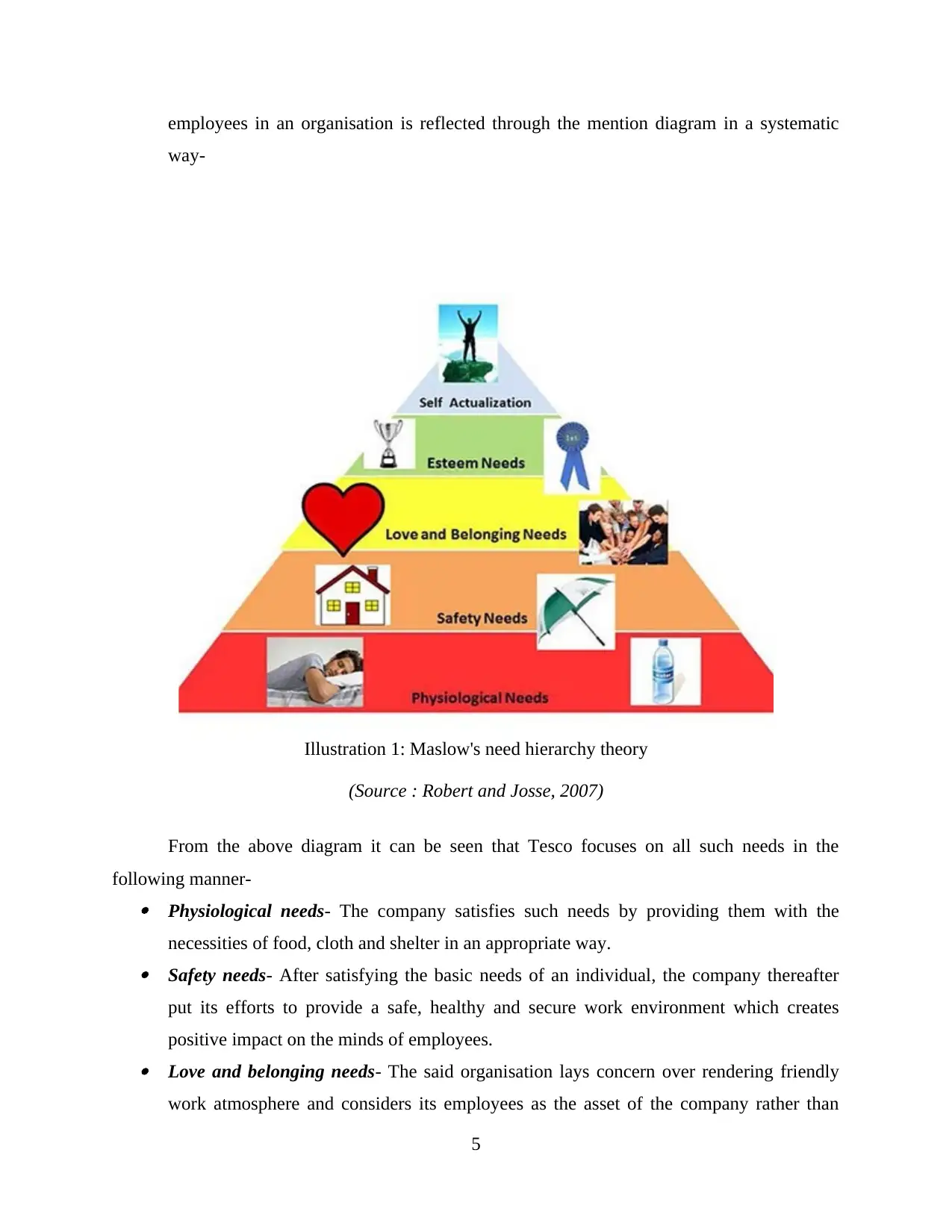
employees in an organisation is reflected through the mention diagram in a systematic
way-
From the above diagram it can be seen that Tesco focuses on all such needs in the
following manner- Physiological needs- The company satisfies such needs by providing them with the
necessities of food, cloth and shelter in an appropriate way. Safety needs- After satisfying the basic needs of an individual, the company thereafter
put its efforts to provide a safe, healthy and secure work environment which creates
positive impact on the minds of employees. Love and belonging needs- The said organisation lays concern over rendering friendly
work atmosphere and considers its employees as the asset of the company rather than
5
Illustration 1: Maslow's need hierarchy theory
(Source : Robert and Josse, 2007)
way-
From the above diagram it can be seen that Tesco focuses on all such needs in the
following manner- Physiological needs- The company satisfies such needs by providing them with the
necessities of food, cloth and shelter in an appropriate way. Safety needs- After satisfying the basic needs of an individual, the company thereafter
put its efforts to provide a safe, healthy and secure work environment which creates
positive impact on the minds of employees. Love and belonging needs- The said organisation lays concern over rendering friendly
work atmosphere and considers its employees as the asset of the company rather than
5
Illustration 1: Maslow's need hierarchy theory
(Source : Robert and Josse, 2007)
Paraphrase This Document
Need a fresh take? Get an instant paraphrase of this document with our AI Paraphraser
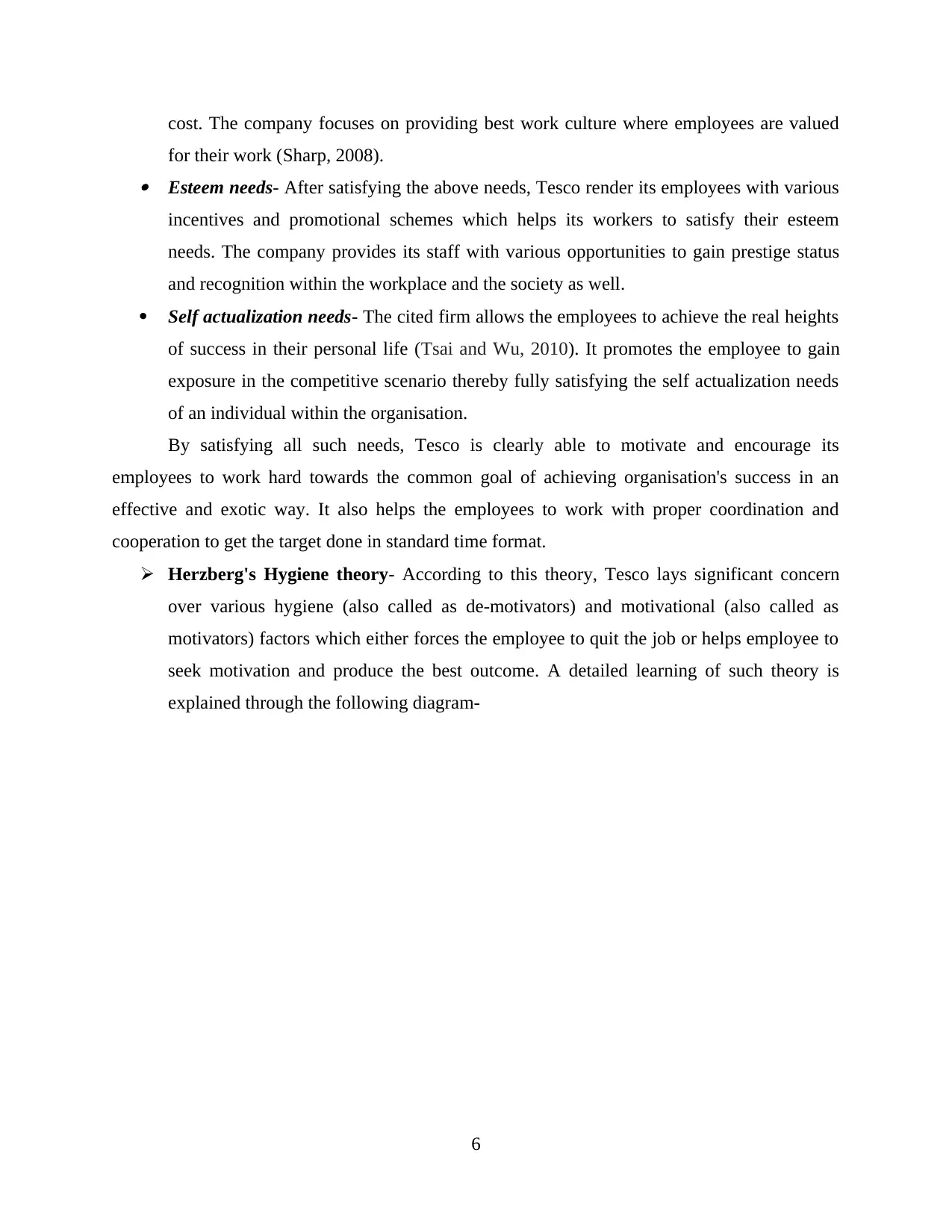
cost. The company focuses on providing best work culture where employees are valued
for their work (Sharp, 2008). Esteem needs- After satisfying the above needs, Tesco render its employees with various
incentives and promotional schemes which helps its workers to satisfy their esteem
needs. The company provides its staff with various opportunities to gain prestige status
and recognition within the workplace and the society as well.
Self actualization needs- The cited firm allows the employees to achieve the real heights
of success in their personal life (Tsai and Wu, 2010). It promotes the employee to gain
exposure in the competitive scenario thereby fully satisfying the self actualization needs
of an individual within the organisation.
By satisfying all such needs, Tesco is clearly able to motivate and encourage its
employees to work hard towards the common goal of achieving organisation's success in an
effective and exotic way. It also helps the employees to work with proper coordination and
cooperation to get the target done in standard time format.
Herzberg's Hygiene theory- According to this theory, Tesco lays significant concern
over various hygiene (also called as de-motivators) and motivational (also called as
motivators) factors which either forces the employee to quit the job or helps employee to
seek motivation and produce the best outcome. A detailed learning of such theory is
explained through the following diagram-
6
for their work (Sharp, 2008). Esteem needs- After satisfying the above needs, Tesco render its employees with various
incentives and promotional schemes which helps its workers to satisfy their esteem
needs. The company provides its staff with various opportunities to gain prestige status
and recognition within the workplace and the society as well.
Self actualization needs- The cited firm allows the employees to achieve the real heights
of success in their personal life (Tsai and Wu, 2010). It promotes the employee to gain
exposure in the competitive scenario thereby fully satisfying the self actualization needs
of an individual within the organisation.
By satisfying all such needs, Tesco is clearly able to motivate and encourage its
employees to work hard towards the common goal of achieving organisation's success in an
effective and exotic way. It also helps the employees to work with proper coordination and
cooperation to get the target done in standard time format.
Herzberg's Hygiene theory- According to this theory, Tesco lays significant concern
over various hygiene (also called as de-motivators) and motivational (also called as
motivators) factors which either forces the employee to quit the job or helps employee to
seek motivation and produce the best outcome. A detailed learning of such theory is
explained through the following diagram-
6
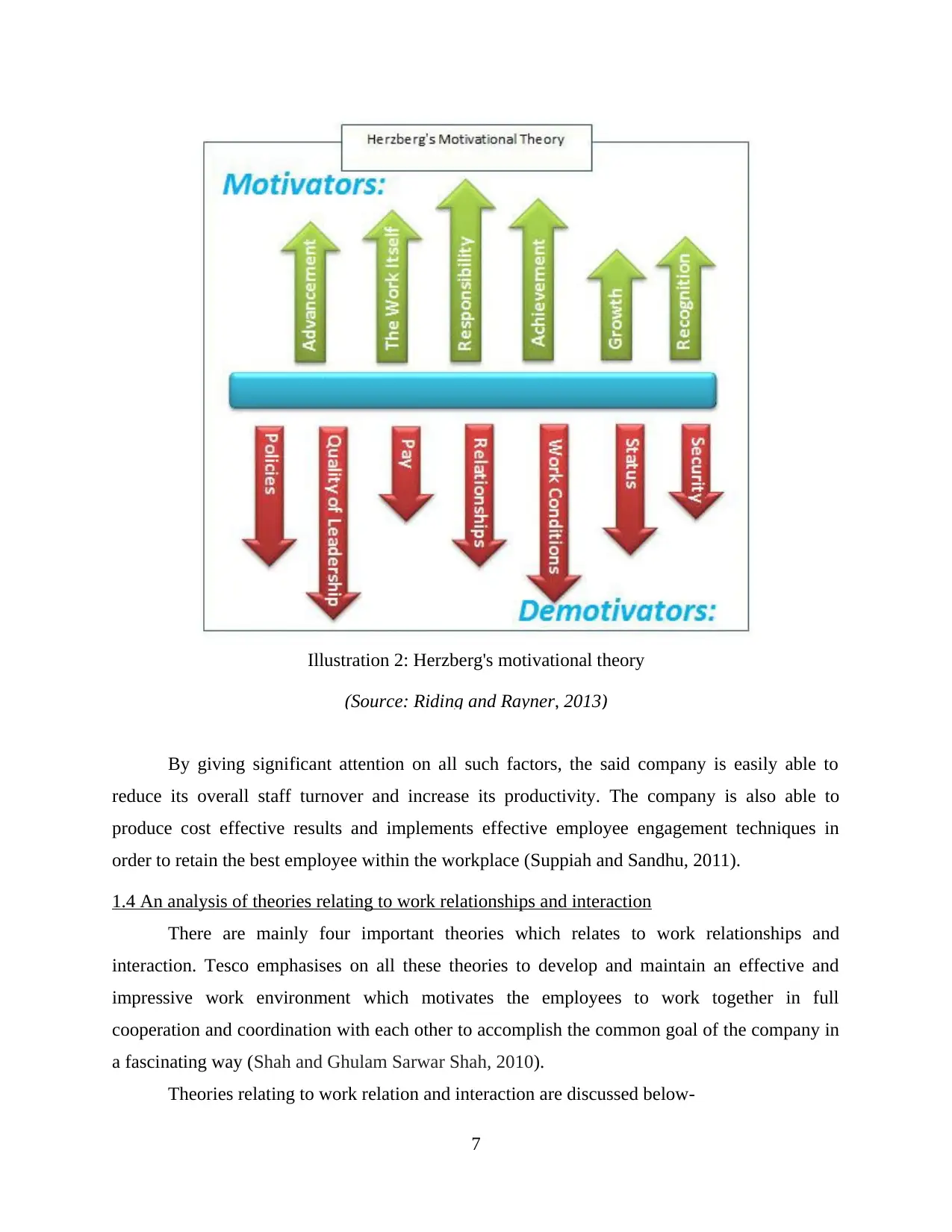
By giving significant attention on all such factors, the said company is easily able to
reduce its overall staff turnover and increase its productivity. The company is also able to
produce cost effective results and implements effective employee engagement techniques in
order to retain the best employee within the workplace (Suppiah and Sandhu, 2011).
1.4 An analysis of theories relating to work relationships and interaction
There are mainly four important theories which relates to work relationships and
interaction. Tesco emphasises on all these theories to develop and maintain an effective and
impressive work environment which motivates the employees to work together in full
cooperation and coordination with each other to accomplish the common goal of the company in
a fascinating way (Shah and Ghulam Sarwar Shah, 2010).
Theories relating to work relation and interaction are discussed below-
7
Illustration 2: Herzberg's motivational theory
(Source: Riding and Rayner, 2013)
reduce its overall staff turnover and increase its productivity. The company is also able to
produce cost effective results and implements effective employee engagement techniques in
order to retain the best employee within the workplace (Suppiah and Sandhu, 2011).
1.4 An analysis of theories relating to work relationships and interaction
There are mainly four important theories which relates to work relationships and
interaction. Tesco emphasises on all these theories to develop and maintain an effective and
impressive work environment which motivates the employees to work together in full
cooperation and coordination with each other to accomplish the common goal of the company in
a fascinating way (Shah and Ghulam Sarwar Shah, 2010).
Theories relating to work relation and interaction are discussed below-
7
Illustration 2: Herzberg's motivational theory
(Source: Riding and Rayner, 2013)
⊘ This is a preview!⊘
Do you want full access?
Subscribe today to unlock all pages.

Trusted by 1+ million students worldwide
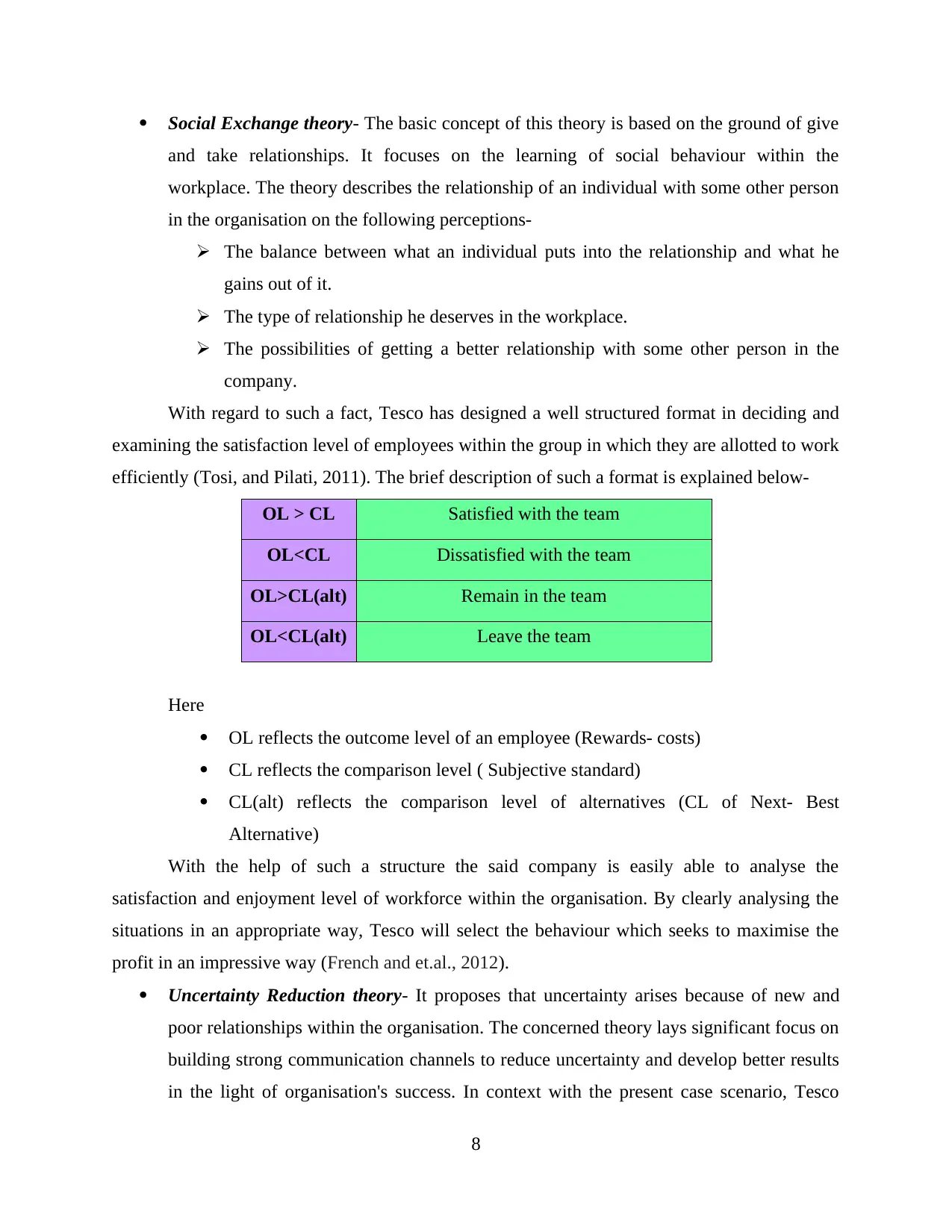
Social Exchange theory- The basic concept of this theory is based on the ground of give
and take relationships. It focuses on the learning of social behaviour within the
workplace. The theory describes the relationship of an individual with some other person
in the organisation on the following perceptions-
The balance between what an individual puts into the relationship and what he
gains out of it.
The type of relationship he deserves in the workplace.
The possibilities of getting a better relationship with some other person in the
company.
With regard to such a fact, Tesco has designed a well structured format in deciding and
examining the satisfaction level of employees within the group in which they are allotted to work
efficiently (Tosi, and Pilati, 2011). The brief description of such a format is explained below-
OL > CL Satisfied with the team
OL<CL Dissatisfied with the team
OL>CL(alt) Remain in the team
OL<CL(alt) Leave the team
Here
OL reflects the outcome level of an employee (Rewards- costs)
CL reflects the comparison level ( Subjective standard)
CL(alt) reflects the comparison level of alternatives (CL of Next- Best
Alternative)
With the help of such a structure the said company is easily able to analyse the
satisfaction and enjoyment level of workforce within the organisation. By clearly analysing the
situations in an appropriate way, Tesco will select the behaviour which seeks to maximise the
profit in an impressive way (French and et.al., 2012).
Uncertainty Reduction theory- It proposes that uncertainty arises because of new and
poor relationships within the organisation. The concerned theory lays significant focus on
building strong communication channels to reduce uncertainty and develop better results
in the light of organisation's success. In context with the present case scenario, Tesco
8
and take relationships. It focuses on the learning of social behaviour within the
workplace. The theory describes the relationship of an individual with some other person
in the organisation on the following perceptions-
The balance between what an individual puts into the relationship and what he
gains out of it.
The type of relationship he deserves in the workplace.
The possibilities of getting a better relationship with some other person in the
company.
With regard to such a fact, Tesco has designed a well structured format in deciding and
examining the satisfaction level of employees within the group in which they are allotted to work
efficiently (Tosi, and Pilati, 2011). The brief description of such a format is explained below-
OL > CL Satisfied with the team
OL<CL Dissatisfied with the team
OL>CL(alt) Remain in the team
OL<CL(alt) Leave the team
Here
OL reflects the outcome level of an employee (Rewards- costs)
CL reflects the comparison level ( Subjective standard)
CL(alt) reflects the comparison level of alternatives (CL of Next- Best
Alternative)
With the help of such a structure the said company is easily able to analyse the
satisfaction and enjoyment level of workforce within the organisation. By clearly analysing the
situations in an appropriate way, Tesco will select the behaviour which seeks to maximise the
profit in an impressive way (French and et.al., 2012).
Uncertainty Reduction theory- It proposes that uncertainty arises because of new and
poor relationships within the organisation. The concerned theory lays significant focus on
building strong communication channels to reduce uncertainty and develop better results
in the light of organisation's success. In context with the present case scenario, Tesco
8
Paraphrase This Document
Need a fresh take? Get an instant paraphrase of this document with our AI Paraphraser
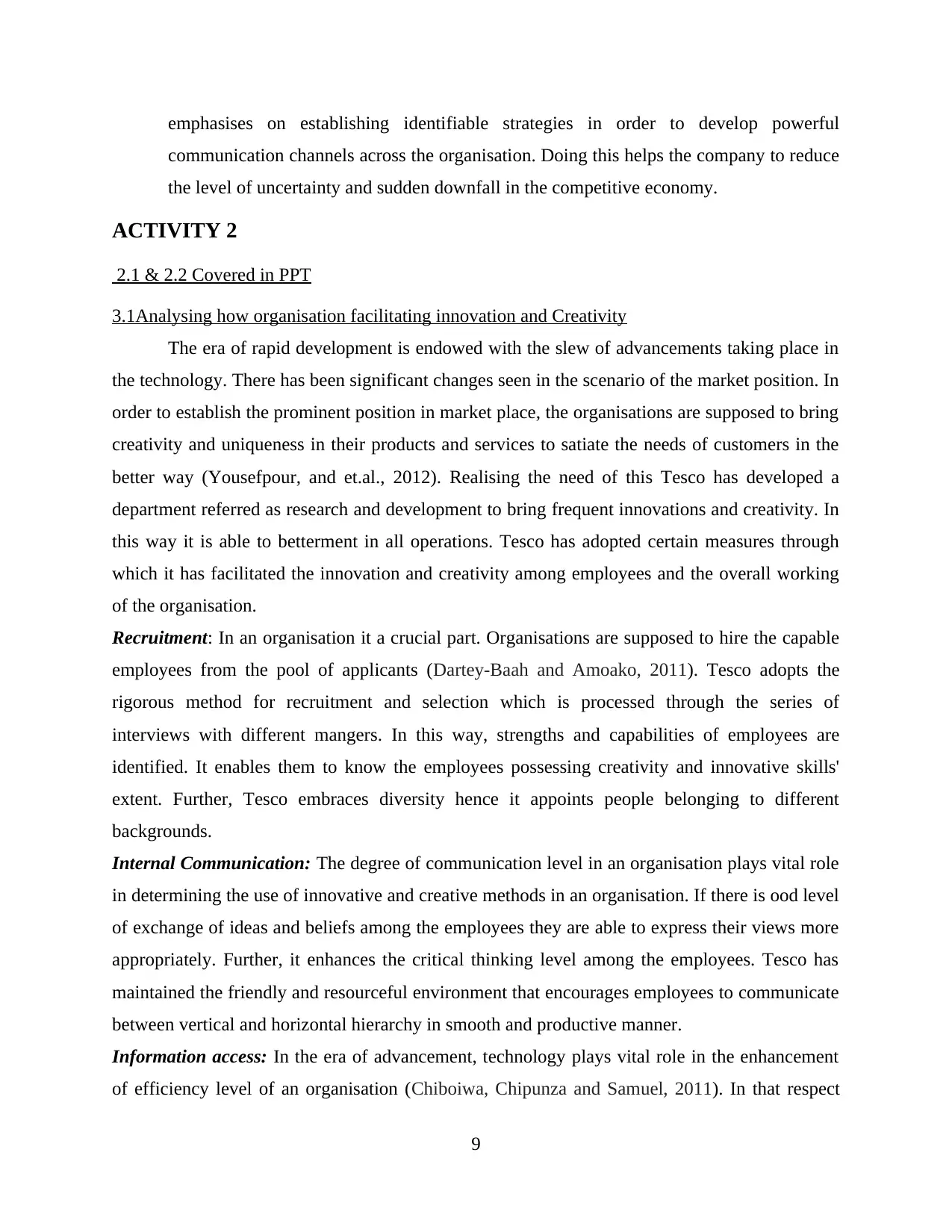
emphasises on establishing identifiable strategies in order to develop powerful
communication channels across the organisation. Doing this helps the company to reduce
the level of uncertainty and sudden downfall in the competitive economy.
ACTIVITY 2
2.1 & 2.2 Covered in PPT
3.1Analysing how organisation facilitating innovation and Creativity
The era of rapid development is endowed with the slew of advancements taking place in
the technology. There has been significant changes seen in the scenario of the market position. In
order to establish the prominent position in market place, the organisations are supposed to bring
creativity and uniqueness in their products and services to satiate the needs of customers in the
better way (Yousefpour, and et.al., 2012). Realising the need of this Tesco has developed a
department referred as research and development to bring frequent innovations and creativity. In
this way it is able to betterment in all operations. Tesco has adopted certain measures through
which it has facilitated the innovation and creativity among employees and the overall working
of the organisation.
Recruitment: In an organisation it a crucial part. Organisations are supposed to hire the capable
employees from the pool of applicants (Dartey-Baah and Amoako, 2011). Tesco adopts the
rigorous method for recruitment and selection which is processed through the series of
interviews with different mangers. In this way, strengths and capabilities of employees are
identified. It enables them to know the employees possessing creativity and innovative skills'
extent. Further, Tesco embraces diversity hence it appoints people belonging to different
backgrounds.
Internal Communication: The degree of communication level in an organisation plays vital role
in determining the use of innovative and creative methods in an organisation. If there is ood level
of exchange of ideas and beliefs among the employees they are able to express their views more
appropriately. Further, it enhances the critical thinking level among the employees. Tesco has
maintained the friendly and resourceful environment that encourages employees to communicate
between vertical and horizontal hierarchy in smooth and productive manner.
Information access: In the era of advancement, technology plays vital role in the enhancement
of efficiency level of an organisation (Chiboiwa, Chipunza and Samuel, 2011). In that respect
9
communication channels across the organisation. Doing this helps the company to reduce
the level of uncertainty and sudden downfall in the competitive economy.
ACTIVITY 2
2.1 & 2.2 Covered in PPT
3.1Analysing how organisation facilitating innovation and Creativity
The era of rapid development is endowed with the slew of advancements taking place in
the technology. There has been significant changes seen in the scenario of the market position. In
order to establish the prominent position in market place, the organisations are supposed to bring
creativity and uniqueness in their products and services to satiate the needs of customers in the
better way (Yousefpour, and et.al., 2012). Realising the need of this Tesco has developed a
department referred as research and development to bring frequent innovations and creativity. In
this way it is able to betterment in all operations. Tesco has adopted certain measures through
which it has facilitated the innovation and creativity among employees and the overall working
of the organisation.
Recruitment: In an organisation it a crucial part. Organisations are supposed to hire the capable
employees from the pool of applicants (Dartey-Baah and Amoako, 2011). Tesco adopts the
rigorous method for recruitment and selection which is processed through the series of
interviews with different mangers. In this way, strengths and capabilities of employees are
identified. It enables them to know the employees possessing creativity and innovative skills'
extent. Further, Tesco embraces diversity hence it appoints people belonging to different
backgrounds.
Internal Communication: The degree of communication level in an organisation plays vital role
in determining the use of innovative and creative methods in an organisation. If there is ood level
of exchange of ideas and beliefs among the employees they are able to express their views more
appropriately. Further, it enhances the critical thinking level among the employees. Tesco has
maintained the friendly and resourceful environment that encourages employees to communicate
between vertical and horizontal hierarchy in smooth and productive manner.
Information access: In the era of advancement, technology plays vital role in the enhancement
of efficiency level of an organisation (Chiboiwa, Chipunza and Samuel, 2011). In that respect
9
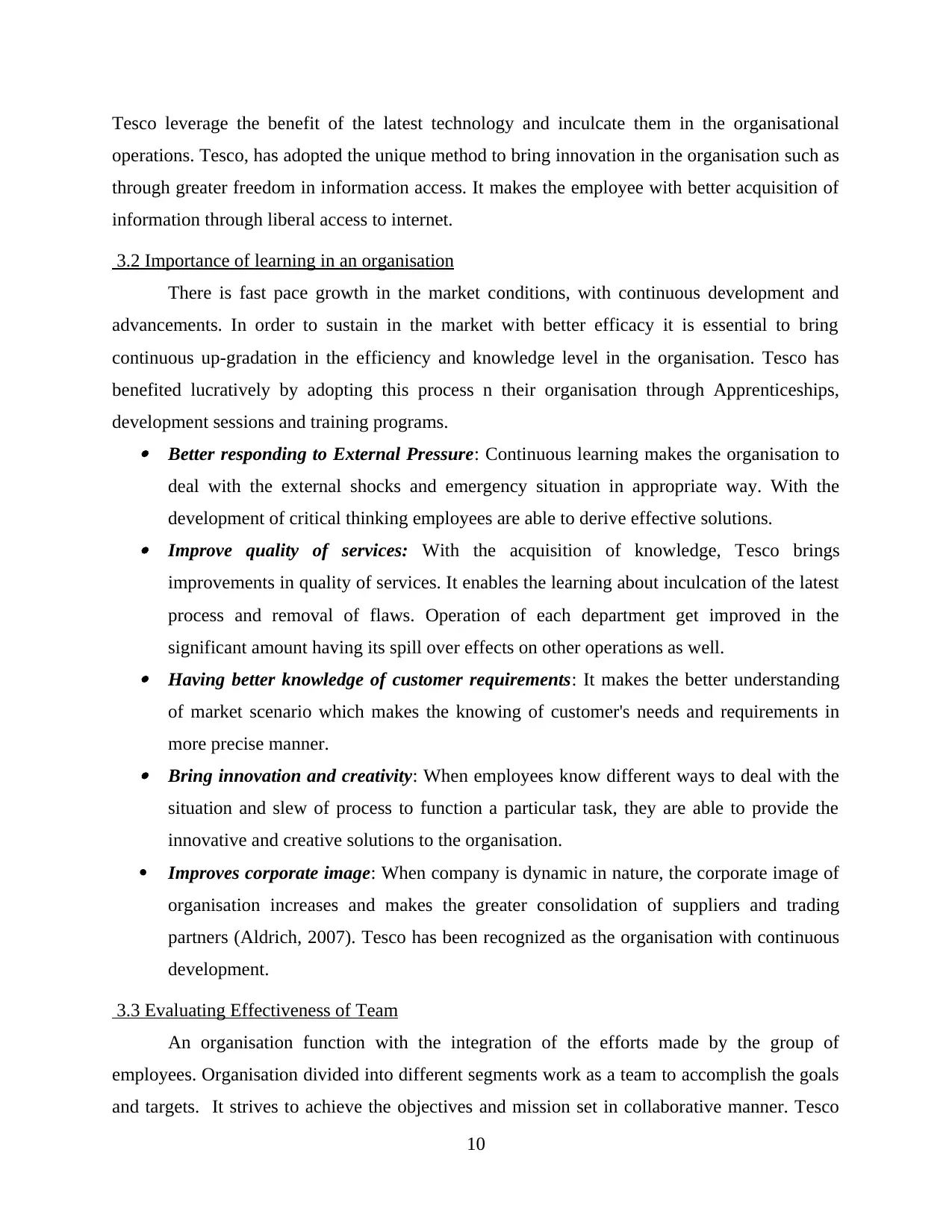
Tesco leverage the benefit of the latest technology and inculcate them in the organisational
operations. Tesco, has adopted the unique method to bring innovation in the organisation such as
through greater freedom in information access. It makes the employee with better acquisition of
information through liberal access to internet.
3.2 Importance of learning in an organisation
There is fast pace growth in the market conditions, with continuous development and
advancements. In order to sustain in the market with better efficacy it is essential to bring
continuous up-gradation in the efficiency and knowledge level in the organisation. Tesco has
benefited lucratively by adopting this process n their organisation through Apprenticeships,
development sessions and training programs. Better responding to External Pressure: Continuous learning makes the organisation to
deal with the external shocks and emergency situation in appropriate way. With the
development of critical thinking employees are able to derive effective solutions. Improve quality of services: With the acquisition of knowledge, Tesco brings
improvements in quality of services. It enables the learning about inculcation of the latest
process and removal of flaws. Operation of each department get improved in the
significant amount having its spill over effects on other operations as well. Having better knowledge of customer requirements: It makes the better understanding
of market scenario which makes the knowing of customer's needs and requirements in
more precise manner. Bring innovation and creativity: When employees know different ways to deal with the
situation and slew of process to function a particular task, they are able to provide the
innovative and creative solutions to the organisation.
Improves corporate image: When company is dynamic in nature, the corporate image of
organisation increases and makes the greater consolidation of suppliers and trading
partners (Aldrich, 2007). Tesco has been recognized as the organisation with continuous
development.
3.3 Evaluating Effectiveness of Team
An organisation function with the integration of the efforts made by the group of
employees. Organisation divided into different segments work as a team to accomplish the goals
and targets. It strives to achieve the objectives and mission set in collaborative manner. Tesco
10
operations. Tesco, has adopted the unique method to bring innovation in the organisation such as
through greater freedom in information access. It makes the employee with better acquisition of
information through liberal access to internet.
3.2 Importance of learning in an organisation
There is fast pace growth in the market conditions, with continuous development and
advancements. In order to sustain in the market with better efficacy it is essential to bring
continuous up-gradation in the efficiency and knowledge level in the organisation. Tesco has
benefited lucratively by adopting this process n their organisation through Apprenticeships,
development sessions and training programs. Better responding to External Pressure: Continuous learning makes the organisation to
deal with the external shocks and emergency situation in appropriate way. With the
development of critical thinking employees are able to derive effective solutions. Improve quality of services: With the acquisition of knowledge, Tesco brings
improvements in quality of services. It enables the learning about inculcation of the latest
process and removal of flaws. Operation of each department get improved in the
significant amount having its spill over effects on other operations as well. Having better knowledge of customer requirements: It makes the better understanding
of market scenario which makes the knowing of customer's needs and requirements in
more precise manner. Bring innovation and creativity: When employees know different ways to deal with the
situation and slew of process to function a particular task, they are able to provide the
innovative and creative solutions to the organisation.
Improves corporate image: When company is dynamic in nature, the corporate image of
organisation increases and makes the greater consolidation of suppliers and trading
partners (Aldrich, 2007). Tesco has been recognized as the organisation with continuous
development.
3.3 Evaluating Effectiveness of Team
An organisation function with the integration of the efforts made by the group of
employees. Organisation divided into different segments work as a team to accomplish the goals
and targets. It strives to achieve the objectives and mission set in collaborative manner. Tesco
10
⊘ This is a preview!⊘
Do you want full access?
Subscribe today to unlock all pages.

Trusted by 1+ million students worldwide
1 out of 21
Related Documents
Your All-in-One AI-Powered Toolkit for Academic Success.
+13062052269
info@desklib.com
Available 24*7 on WhatsApp / Email
![[object Object]](/_next/static/media/star-bottom.7253800d.svg)
Unlock your academic potential
Copyright © 2020–2025 A2Z Services. All Rights Reserved. Developed and managed by ZUCOL.





